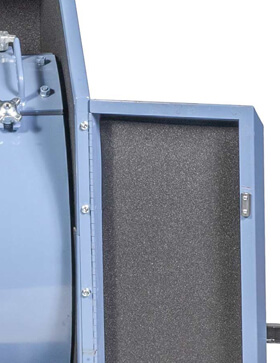
Part one of this two-part blog series discussed how the informed selection of testing equipment can help control dust levels in a construction materials laboratory. For this installment, we’ll continue the discussion, focusing on noise reduction features of some selected laboratory testing equipment.
In the early years of aggregate, asphalt, concrete, and soils testing, laboratory testing equipment focused on efficient production of accurate, repeatable results. Worker safety and comfort were often an afterthought and sometimes bypassed by both manufacturers and consumers for economic considerations. Today, insistence on accurate results and efficient performance has not changed, but attitudes toward worker protection have evolved. The Occupational Safety and Health Administration (OSHA) standard 29 CFR 1910.95 is the federal regulation for occupational noise exposure.
Noise and dust are completely different in most respects, but they share one common property; they propagate through the air. This means that simply limiting the open space around the testing apparatus is a good first step in controlling both. A well-designed and engineered enclosure stops dust and alters sound characteristics to reduce the loudness, or sound pressure measured in decibels (dB), of operating equipment. An explanation of some basic properties of noise can be found on this fact sheet, courtesy of the Canadian Centre for Occupational Health & Safety.
Choosing Lab Equipment
Looking at high-quality testing equipment to add to your lab carries an expectation that it will perform the task it was built for and meet the requirements of relevant ASTM or AASHTO standard test methods. At Gilson, we believe good design also includes features that add safety, reliability, and convenience to our products. Selecting just one machine designed with these features is beneficial, but a routine practice of outfitting a lab with such devices will have a greater impact when it comes to overall efficiency, production, and worker protection.
- Silent Testing Screen (TS-4) is the newest version of the classic Testing Screen, redesigned for quieter, cleaner operation. Improved housing is lined with sound attenuating material. Sealed front doors open to access the Testing Screen trays and a hinged horizontal trap door cover the top material feed opening. The built-in electronic countdown timer controls cycle times and pauses. Testing Screens are built to process larger samples of coarse material.
- Test-Master® Testing Screens also have the capacity for large samples and use the same screen trays as the Testing Screen. Test-Master® models feature a convenient material-feeding hopper. A sound-deadening enclosure and smooth, counterbalanced operation combine to reduce operational noise levels.
- Silent Sifters® are advanced rotary sifters that use conventional round test sieves for accurate and repeatable gradation tests on granular materials. Silent Sifters® uses advanced acoustic materials and quality sealed cabinetry to greatly reduce noise levels in the lab and virtually eliminate airborne dust during operation.
- Vibratory Sieve Shakers can be an effective alternative to rotary sifters or mechanical shakers for some applications. Their mechanisms are often quieter, and the vibratory action produces accurate separations on materials and particle sizes within a limited range. They are not designed with enclosures but can be located inside available sound enclosures if desired.
- Sound Enclosures are steel cabinets lined with sound-attenuating foam. Originally designed for sieve shakers and testing screens, their generous size makes them useful to house a variety of noisy or dusty materials testing machines. Cabinet-style sealed doors to prevent dust from escaping and they are lined with sound-attenuating foam.
- As mentioned in part one of this series, the Los Angeles (LA) abrasion test can output considerable dust and operates at a very high noise level. Mineral aggregates and large steel balls are rotated together in a large steel drum, repeatedly dropping against the interior. Gilson redesigned the Los Angeles Abrasion Machine to address dust, noise, and safety issues by enclosing the rotating drum in a sound-attenuated steel cabinet.

We hope this short series on equipment for noise and dust reduction in the lab has been informative and has given you some ideas on making your lab a better place to work.
Gilson Is Here to Help
Contact our testing experts for more information or to discuss your testing application.
Testing Resources
Standard Test Methods, Specifications, and Practices
Individual test methods and specifications referenced in our product descriptions, blog articles, and videos are available for review or purchase from the professional organizations noted.
- ASTM International (American Society for Testing and Materials)
- AASHTO (American Association of State Highway and Transportation Officials)
- ACI (American Concrete Institute)
- State DOTs (Departments of Transportation)
- ISO (International Organization for Standardization)
- BS (British Standards)
- EN (European Standards)

















